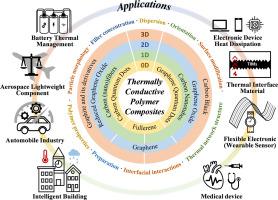Effect of carbon-based fillers on the thermal conductivity of polymers: A review
IF 5.8
2区 工程技术
Q1 ENGINEERING, MECHANICAL
International Journal of Heat and Mass Transfer
Pub Date : 2025-07-26
DOI:10.1016/j.ijheatmasstransfer.2025.127576
引用次数: 0
Abstract
Polymers are extensively utilized in automotive, medical, and aerospace sectors due to their low density, high strength, ease of processing, and durability. However, their inherently low thermal conductivity limits their effectiveness in heat transfer and dissipation applications. The incorporation of high-thermal-conductivity fillers offers a viable strategy to enhance thermal transport efficiency. Carbon-based materials, characterized by their high crystallinity and exceptional intrinsic thermal conductivity, have shown great promise. When integrated into polymer matrices, these carbon-based fillers facilitate the formation of continuous thermal conduction pathways, significantly improving the overall thermal performance of polymer composites, rendering them highly suitable for thermal management applications. This review provides a comprehensive overview of the effects of incorporating various commonly used carbon-based materials as well as the role of hybridized carbon structures in enhancing composite performance. By optimizing factors such as filler size, concentration, surface modification, dispersion uniformity, orientation within the matrix, interfacial interactions with the polymer, and hybridization strategies, the development of efficient thermal conduction networks can be further promoted. Compared to conventional fillers, carbon-based fillers exhibit superior thermal conductivity, expanding the application scope of polymer composites in areas such as construction, thermal interface materials, electronic devices, and battery thermal management. To fully realize the potential of carbon fillers/polymer composites and extend their practical applications, further theoretical and experimental investigations are essential to achieve a deeper understanding of their thermal transport mechanisms and interfacial interactions.

碳基填料对聚合物导热性能的影响
聚合物由于其低密度、高强度、易于加工和耐用性而广泛应用于汽车、医疗和航空航天领域。然而,其固有的低导热性限制了其在传热和散热应用中的有效性。高导热填料的掺入为提高热传导效率提供了一种可行的策略。碳基材料以其高结晶度和优异的固有导热性为特点,具有广阔的应用前景。当集成到聚合物基体中时,这些碳基填料促进了连续热传导途径的形成,显著提高了聚合物复合材料的整体热性能,使其非常适合热管理应用。本文综述了各种常用碳基材料在复合材料中的应用效果以及杂化碳结构在提高复合材料性能方面的作用。通过优化填料尺寸、浓度、表面改性、分散均匀性、基质内取向、与聚合物的界面相互作用以及杂化策略等因素,可以进一步促进高效热传导网络的发展。与传统填料相比,碳基填料表现出优异的导热性,扩大了聚合物复合材料在建筑、热界面材料、电子设备和电池热管理等领域的应用范围。为了充分发挥碳填料/聚合物复合材料的潜力并扩展其实际应用,需要进一步的理论和实验研究来深入了解其热传递机制和界面相互作用。
本文章由计算机程序翻译,如有差异,请以英文原文为准。
求助全文
约1分钟内获得全文
求助全文
来源期刊
CiteScore
10.30
自引率
13.50%
发文量
1319
审稿时长
41 days
期刊介绍:
International Journal of Heat and Mass Transfer is the vehicle for the exchange of basic ideas in heat and mass transfer between research workers and engineers throughout the world. It focuses on both analytical and experimental research, with an emphasis on contributions which increase the basic understanding of transfer processes and their application to engineering problems.
Topics include:
-New methods of measuring and/or correlating transport-property data
-Energy engineering
-Environmental applications of heat and/or mass transfer

 求助内容:
求助内容: 应助结果提醒方式:
应助结果提醒方式:


